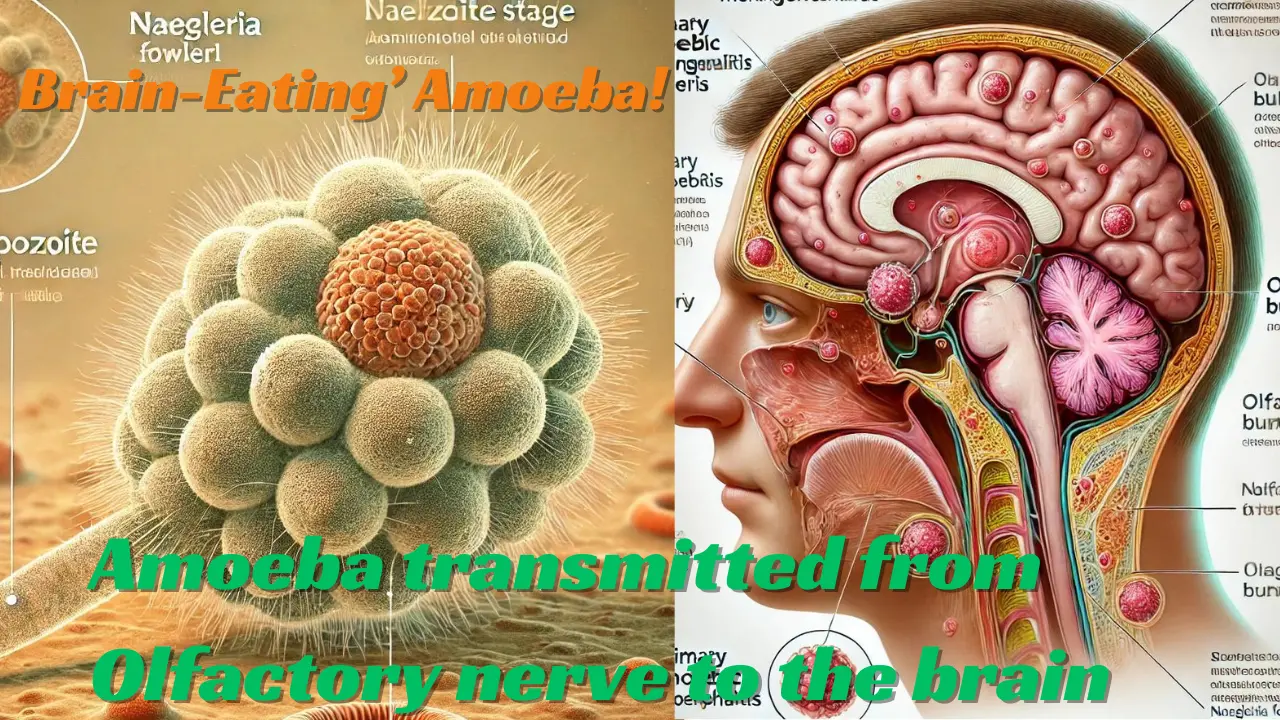
A 14-year-old boy, has tragically died of amoebic meningoencephalitis which is a rare brain infection caused by a brain-eating amoeba called “Naegleria fowleri”. This marks the third such death in Kerala within the last two months—as two others involved a 5-year-old girl from Malappuram in May and another one aged 13 years old in June, both succumbing to the same ailment.
Table of Contents
Understanding the Brain-Eating Amoeba:
What is 'Brain-Eating' Amoeba?

“Naegleria fowleri”, or the so-called brain-eating amoeba, is a free-living amoeba which thrives in warm freshwater environments such as lakes, rivers, and hot springs. According to the Centers for Disease Control and Prevention (CDC), this amoeba is responsible for a rare but severe brain infection known as Primary Amoebic Meningoencephalitis(PAM). Despite being extremely uncommon, it is almost always fatal since it kills brain tissue leading to severe neurological effects.
How does brain-eating amoeba spread?
In fact these infections mainly happen through inhalation from the nasal douching water into one’s body which usually occurs while swimming or diving inside any warm freshwater bodies. Through olfactory nerve, the amoeba would then move from this point up to brain and result into an infection. It should be noted that the disease cannot be transmitted from one person to another or by drinking the same water.

Recent Cases in Kerala
Case Details:
On June 24, a boy, aged fourteen (14) from Kozhikode got admitted into hospital having shown symptoms such as severe headache, nausea and vomiting. However, despite all the efforts from medics, he did not survive the night of 3rd July. His death comes after that of a five-year-old girl in Malappuram on May 21 and also a 13 years old one from Kannur on 25th June both having symptoms that were linked to bathing in infected water.
Also Read
PAM Symptoms and Diagnosis:
Early versus late stage manifestations:
It typically takes two to 15 days for the symptoms of PAM to show up. At first, patients may suffer from an intense headache that is frontal or bilateral, fever, vomiting and stiff neck. But as the condition progresses they can exhibit symptoms such as confusion, lack of attention, ataxia, seizures, hallucinations or coma. These severe signs imply urgent need for medical help since the disease advances rapidly killing its victims most times.
Diagnosis Challenge:
The process of diagnosing PAM can be complex since during preliminary stages it has similar symptoms with bacterial as well as viral meningitis. This usually entails amoeba detection from cerebrospinal fluid samples using advanced laboratory techniques like polymerase chain reaction (PCR) tests.
Treatment and Prevention:
Treatment Options:
The treatment of PAM has proved to be very difficult due to its rapid progression and high mortality rates. According to CDC, a variety of medications is used in combination including antifungals, antimicrobials and supportive therapies. Nonetheless, the success rate remains poor with a mortality rate above 95%. Some survivors from North America were administered amphotericin B, rifampin, fluconazole and miltefosine while receiving treatment- a clear demonstration that aggressive therapy is necessary if one is to survive.
Preventive Measures:
There are need for preventive strategies so as to reduce chances (risk) of getting these infections. Swimming advisories have been issued by health department officials urging residents not to swim in warm fresh water bodies especially stagnant ones in Kerala Proper chlorination and maintenance of swimming pools and water parks are also emphasized to prevent the growth of amoeba. Therefore, persons swimming in potentially contaminated waters should avoid activities which strongly generate pressure since nose clips can be used to prevent this.

Response by the Health Authorities:
Following recent deaths in Kerala due to the brain-eating amoeba (Naegleria fowleri), monitoring and preventive measures in the district have been stepped up by the Health Department, Kerala. Authorities are concentrating on public education on dangers of swimming in natural water bodies and importance of keeping clean. Others include identifying sources of contamination and closing them to stop any more cases.
Conclusion:
The deaths associated with Naegleria fowleri, a killer amoeba of the human brain, in Kerala raise an alarm for more awareness and preventative measures against such occurrence in young people especially.
Although PAM is only an infection that happens rarely, its harmfulness necessitates continuous monitoring together with immediate action aimed at safeguarding public health from it. As researchers continue to explore better treatment options, public education and preventive strategies remain the best defense against this deadly organism.
Deadly brain-eating amoeba kills Indian boy. Here's what it is and how it infects people https://t.co/elcKgPfaTE
— WION (@WIONews) July 4, 2024




4 thoughts on “‘Brain-Eating’ Amoeba Claims 3rd Life in Kerala: What You Need to Know”